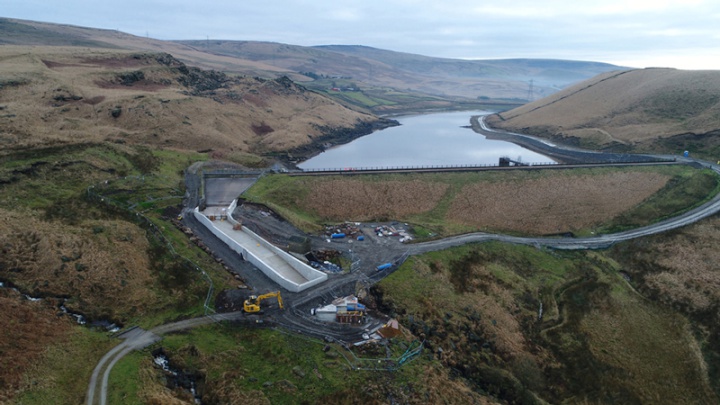Seequent brings 3D modelling to civil engineering industries
Seequent releases Leapfrog Works, brings 3D modelling
and visualisation to civil engineering and environmental
industries

CHRISTCHURCH, NZ – February 27, 2018 – Seequent (formerly ARANZ Geo), a world leader in the development of data visualisation software, today announced the release of Leapfrog® Works for the civil engineering and environmental industries. Built on the trusted Leapfrog 3D implicit modelling engine, Leapfrog Worksimproves understanding, visualisation and communication of subsurface conditions and the interaction with infrastructure.
“A long-time challenge for the industry has been the disparate processes of designing infrastructure and ground engineering, from tender to feasibility to operational phases. Working with industry leaders, we’ve developed a modelling solution that pairs a view of the geology with the engineering design, to better communicate the associated risks in projects to stakeholders,” Seequent’s General Manager of Civil and Environmental Daniel Wallace says.
First introduced to the mining and minerals industry close to 15 years ago, Leapfrog® 3D geological modelling solutions are now available for a range of industries to help uncover valuable insights from geological data, to allow better decision making for earth, environment and energy challenges.
Leapfrog Works allows users to build 3D models from geotechnical data in days, not weeks, in an easy to use workflow. Models can be rapidly edited and new data can be easily reimported over the project lifecycle. Leapfrog enables collaboration and file sharing between multiple parties from remote locations using standard IT set up. Powerful 3D visualisations can be readily shared to aid stakeholder communication and understanding at each stage of a project.
Leapfrog Works interfaces and exchanges information with diverse digital design and Building Information Modelling (BIM) and digital geotechnical database platforms. The optional hydrogeology solution kit also integrates with flow simulation packages.
Civil engineering and environmental industries are already “embracing the power of Leapfrog Works” according to Wallace. “We’ve been working alongside Mott MacDonald to identify opportunities to improve understanding and communication of ground conditions in infrastructure and groundwater projects, and support the cultural shift towards digitisation and collaborative working.”
Mott MacDonald, a global engineering, management and development consultancy with over 16,000 employees in 150 countries, provided input into the development of Leapfrog Works. The company has signed a global enterprise agreement to give all geotechnical practitioners access.
“The communication of geotechnical issues to non-specialists has been a long-standing challenge for geotechnics practitioners, however Leapfrog has generated a step change improvement in our ability to communicate geotechnical issues to a wide range of stakeholders,” says Mott MacDonald’s geotechnics global practice leader Tony O’Brien.
Leapfrog unleashes a broad range of
opportunities by enabling an improved understanding of
ground risks and opportunities for innovation from available
historical and investigation data.
O’Brien added,
“The software’s 3D geological models allow our project
teams to thoroughly interrogate ground data from a variety
of sources and field observations. By interrogating data
sources in this way and applying our geotechnics expertise,
we have achieved more efficient design solutions with higher
levels of confidence.
“The outcome was targeted investigation, design, remedial and temporary works solutions. What this means in practice is illustrated by some of the projects we have utilised Leapfrog on. Since using the software, we have seen substantial reductions in the time needed to produce ground models, with associated cost savings compared to traditional approaches.”
Some projects Mott MacDonald has used Leapfrog on include:
• The Upper Chelburn Impounding Reservoir and
Blackpool South Surface Water Separation projects for United
Utilities in the UK. Highly focused solutions were developed
to improve design, deliver savings and assist with
communications between clients, contractors and
neighbours.
• A feasibility assessment of a
large rock cavern network in Singapore based on the
development of complex geological and rock mass strength
models.
• 3D visualisations of a proposed
airport in Indonesia, including handling of very
high-resolution topography, drone imagery, proposed
earthworks and underlying geology over a wide area.
•
Tunnelling projects worldwide, including the modelling of
fault and deep weathering of the geology surrounding a
tunnel in Indonesia that had collapsed during
construction.
• Construction projects such as on
several NHS sites through Scotland to explain site
constraints and enable clear stakeholder engagement.
•
Major transportation projects including the alignment of a
key new transportation route in the UK to assess, categorise
and visualise risk to enable refinements of the route
geometry to avoid higher risk areas and the design of
remedial works.
“Leapfrog Works allows clients to see
the bigger picture and have the clarity and confidence to
make better design and construction decisions; whether
it’s for a road, a building, a dam, or a tunnel,” says
Wallace.
Seequent is contributing to the modelling, understanding and management of geological risk for projects in over 80 countries around the globe. The company’s rapidly growing global footprint includes offices in Australia, Brazil, Canada, Chile, Denmark, Peru, Russia, South Africa, and the UK.
ENDS


 Seafood New Zealand: Seafood Situation Saved By A Sausage: New Plymouth Locals Innovate, Using Crayfish Bait
Seafood New Zealand: Seafood Situation Saved By A Sausage: New Plymouth Locals Innovate, Using Crayfish Bait Takeovers Panel: Takeovers Panel Convenes Meeting To Inquire Into The Acquisition Of Shares In NZME Limited
Takeovers Panel: Takeovers Panel Convenes Meeting To Inquire Into The Acquisition Of Shares In NZME Limited WorkSafe NZ: Conveyor Belt Death-Trap Was A Danger In Plain Sight
WorkSafe NZ: Conveyor Belt Death-Trap Was A Danger In Plain Sight Commerce Commission: 2degrees Fined $325,000 For Misleading Claims About ‘Free’ Aussie Business Roaming
Commerce Commission: 2degrees Fined $325,000 For Misleading Claims About ‘Free’ Aussie Business Roaming  Natural Hazards Commission: Hub Launched To Empower Architects And Engineers To Build Above Code
Natural Hazards Commission: Hub Launched To Empower Architects And Engineers To Build Above Code Harmony Energy: Ceremony Heralds Start Of Construction On New Zealand’s Largest Solar Farm Project
Harmony Energy: Ceremony Heralds Start Of Construction On New Zealand’s Largest Solar Farm Project



